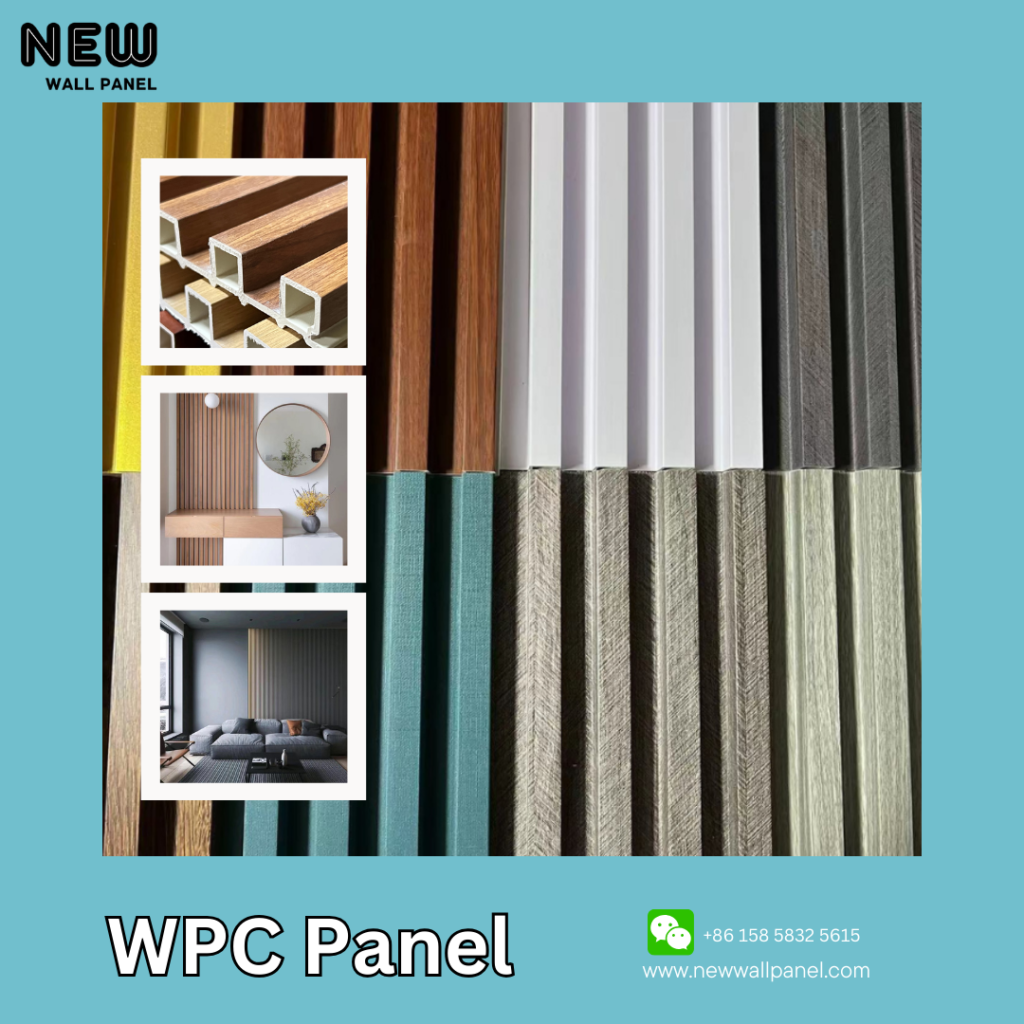WPC (Wood Plastic Composite) wall panels are innovative construction materials that combine wood fibers or flour with plastic polymers to create a durable and versatile panel suitable for interior and exterior applications. These panels offer the natural aesthetic of wood with added benefits such as moisture resistance, insect resistance, and low maintenance requirements, making them an ideal choice for enhancing walls in residential, commercial, and industrial settings.
Is there other name for the wpc wall panel ?
Yes, WPC (Wood Plastic Composite) wall panels may be referred to by different names or terms depending on the manufacturer or region. Some alternative names for WPC wall panels include:
- Composite Wall Panels
- Wood Polymer Composite Panels
- Plastic Wood Panels
- Synthetic Wood Panels
- Engineered Wood Panels
- Wood Composite Cladding
- Eco-Wood Panels
These terms are often used interchangeably to describe wall panels made from a blend of wood fibers or flour and plastic polymers, offering durability, versatility, and aesthetic appeal for interior and exterior applications.
WPC wall panel also called PVC wall panel ?
No, WPC (Wood Plastic Composite) wall panels are not the same as PVC (Polyvinyl Chloride) wall panels. They are distinct materials with different compositions and properties.
WPC wall panels are made from a blend of wood fibers or flour and plastic polymers, offering a combination of natural wood aesthetics and synthetic durability. These panels are often used for both interior and exterior applications due to their weather resistance and low maintenance requirements.
PVC wall panels, on the other hand, are made entirely from synthetic plastic polymer (PVC). They are known for their durability, moisture resistance, and versatility. PVC panels are commonly used in interior applications, such as bathrooms and kitchens, due to their ease of cleaning and resistance to water damage.
While both WPC and PVC wall panels serve similar purposes in terms of wall cladding and decoration, they are made from different materials and offer different benefits. Therefore, they are not typically referred to interchangeably.
Does WPC wall panel also called Fluted wall panel ?
WPC (Wood Plastic Composite) wall panels and fluted wall panels are not necessarily the same thing, although they can share similarities depending on the specific design and construction.
Fluted wall panels refer to architectural panels with a series of parallel grooves or ridges, known as flutes, running vertically along their surface. These flutes create a textured and visually appealing pattern on the panel.
On the other hand, WPC wall panels are composite panels made from a blend of wood fibers or flour and plastic polymers. While some WPC wall panels may have a fluted texture, not all WPC wall panels feature this specific design element. WPC panels can come in various textures, finishes, and patterns, depending on the manufacturer and intended use.
In summary, while there may be some overlap between WPC wall panels and fluted wall panels, they are not necessarily synonymous terms.
What is WOOD fluted wall panel ?
Wood fluted wall panels are architectural panels made from natural wood that feature a series of parallel grooves or ridges, known as flutes, running vertically along their surface. These panels offer a warm and organic aesthetic, showcasing the natural grain and texture of the wood. Wood fluted wall panels are used in interior applications to add visual interest, texture, and warmth to walls, creating a timeless and elegant look. They are available in various wood species, finishes, and sizes, allowing for customization to suit different design styles and preferences.
What is PVC fluted wall panel ?
PVC fluted wall panels are architectural panels featuring a series of parallel grooves or ridges, known as flutes, running vertically along their surface. These panels are made from polyvinyl chloride (PVC), a synthetic plastic material known for its durability, moisture resistance, and versatility. PVC fluted wall panels are used in interior and exterior applications to enhance the aesthetics of buildings, add texture to walls, and provide architectural interest. They come in various colors, textures, and finishes, offering a customizable solution for a wide range of design needs.
PVC fluted wall panel compare with WOOD fluted wall panel
When comparing PVC fluted wall panels with wood fluted wall panels, several factors come into play:
- Material Composition:
- PVC Fluted Wall Panels: Made of polyvinyl chloride (PVC), these panels are entirely synthetic and do not contain any natural wood fibers.
- Wood Fluted Wall Panels: Made from natural wood, these panels feature authentic wood fibers and offer a traditional aesthetic.
- Appearance:
- PVC Fluted Wall Panels: Offer a smooth and uniform appearance with consistent colors and textures. They can mimic the look of wood grain or have a solid color finish.
- Wood Fluted Wall Panels: Feature the natural grain and texture of wood, providing a warm and organic look that is unique to each panel.
- Durability:
- PVC Fluted Wall Panels: Resistant to moisture, rot, and insect damage, PVC panels are suitable for humid environments and outdoor applications. They do not warp, crack, or splinter over time.
- Wood Fluted Wall Panels: Require proper sealing and maintenance to protect against moisture, rot, and insect infestation. They may be less durable than PVC panels and can be prone to warping, cracking, and fading if not properly maintained.
- Maintenance:
- PVC Fluted Wall Panels: Require minimal maintenance, as they are easy to clean with soap and water and do not require staining or sealing.
- Wood Fluted Wall Panels: Require regular sealing, staining, and refinishing to maintain their appearance and protect against moisture damage and wear.
- Environmental Impact:
- PVC Fluted Wall Panels: May have a higher environmental impact due to their reliance on synthetic plastics and manufacturing processes.
- Wood Fluted Wall Panels: Considered more environmentally friendly than PVC panels, as they are made from renewable resources and biodegradable materials.
- Cost:
- PVC Fluted Wall Panels: Generally more affordable than wood panels due to their simpler manufacturing process and lower material costs.
- Wood Fluted Wall Panels: Tend to be more expensive than PVC panels due to the higher cost of natural wood and the additional maintenance required over time.
In summary, PVC fluted wall panels offer durability, low maintenance, and affordability, while wood fluted wall panels provide a natural aesthetic and environmental sustainability. The choice between the two depends on factors such as design preferences, budget, and desired level of maintenance.
PVC fluted wall panel and WOOD fluted wall panel which one is expensive ?
In general, wood fluted wall panels tend to be more expensive than PVC fluted wall panels. Here’s why:
- Material Cost: Wood is a natural material that requires harvesting, processing, and finishing, which can contribute to higher material costs compared to PVC, which is a synthetic material manufactured from readily available chemicals.
- Manufacturing Process: The production process for wood panels, including milling, shaping, and finishing, can be more labor-intensive and time-consuming than the manufacturing process for PVC panels, which can be extruded or molded more efficiently.
- Maintenance: Wood fluted wall panels typically require more maintenance over time, including sealing, staining, and refinishing, to protect against moisture damage, rot, and insect infestation. These additional maintenance requirements can add to the overall cost of wood panels compared to PVC panels, which require minimal maintenance.
- Durability: PVC panels are known for their durability, resistance to moisture, and long lifespan, which can reduce the need for frequent replacements or repairs. In contrast, wood panels may be more susceptible to damage and wear over time, potentially leading to higher long-term costs.
Overall, while the upfront cost of wood fluted wall panels may be higher than PVC panels, some individuals may prefer the natural aesthetic and sustainability of wood, making it a worthwhile investment for certain projects. However, PVC panels offer a more cost-effective and low-maintenance alternative for those seeking a similar look at a lower price point.
PVC fluted wall panel could make any wood look marble look pure color look ?
Yes, PVC fluted wall panels can be manufactured to mimic various looks, including wood, marble, and solid colors. Through advanced printing and embossing techniques, PVC panels can replicate the appearance of different materials with remarkable accuracy. Here are some common finishes that PVC fluted wall panels can achieve:
- Wood Look: PVC panels can be designed to emulate the natural grain, texture, and color variations of different wood species, providing the aesthetic appeal of real wood without the maintenance requirements.
- Marble Look: PVC panels can be printed with high-definition images of marble patterns, complete with realistic veining and coloration, to create the luxurious look of marble at a fraction of the cost.
- Pure Color Look: PVC panels are available in a wide range of solid colors, allowing for customization to match any color scheme or design preference. These panels offer a sleek and uniform appearance, perfect for modern or minimalist interiors.
Overall, PVC fluted wall panels offer versatility in design and aesthetics, making them suitable for various applications and style preferences. Whether you’re looking for the warmth of wood, the elegance of marble, or the simplicity of solid colors, PVC panels can deliver the desired look with ease and affordability.




